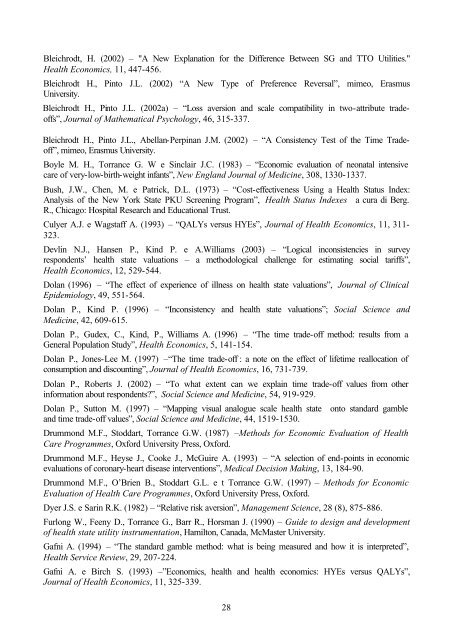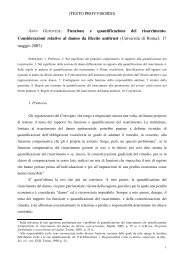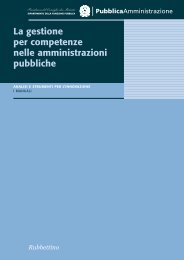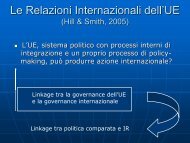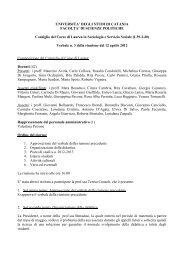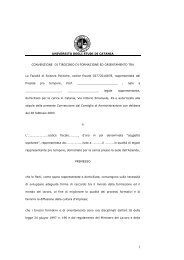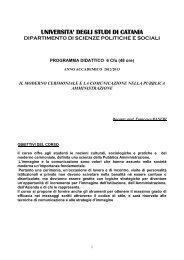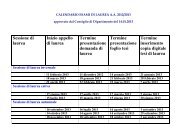La valutazione degli stati di salute sulla base delle preferenze ...
La valutazione degli stati di salute sulla base delle preferenze ...
La valutazione degli stati di salute sulla base delle preferenze ...
You also want an ePaper? Increase the reach of your titles
YUMPU automatically turns print PDFs into web optimized ePapers that Google loves.
Bleichrodt, H. (2002) – "A New Explanation for the Difference Between SG and TTO Utilities."Health Economics, 11, 447-456.Bleichrodt H., Pinto J.L. (2002) “A New Type of Preference Reversal”, mimeo, ErasmusUniversity.Bleichrodt H., Pinto J.L. (2002a) – “Loss aversion and scale compatibility in two-attribute tradeoffs”,Journal of Mathematical Psychology, 46, 315-337.Bleichrodt H., Pinto J.L., Abellan-Perpinan J.M. (2002) – “A Consistency Test of the Time Tradeoff”,mimeo, Erasmus University.Boyle M. H., Torrance G. W e Sinclair J.C. (1983) – “Economic evaluation of neonatal intensivecare of very-low-birth-weight infants”, New England Journal of Me<strong>di</strong>cine, 308, 1330-1337.Bush, J.W., Chen, M. e Patrick, D.L. (1973) – “Cost-effectiveness Using a Health Status Index:Analysis of the New York State PKU Screening Program”, Health Status Indexes a cura <strong>di</strong> Berg.R., Chicago: Hospital Research and Educational Trust.Culyer A.J. e Wagstaff A. (1993) – “QALYs versus HYEs”, Journal of Health Economics, 11, 311-323.Devlin N.J., Hansen P., Kind P. e A.Williams (2003) – “Logical inconsistencies in surveyrespondents’ health state valuations – a methodological challenge for estimating social tariffs”,Health Economics, 12, 529-544.Dolan (1996) – “The effect of experience of illness on health state valuations”, Journal of ClinicalEpidemiology, 49, 551-564.Dolan P., Kind P. (1996) – “Inconsistency and health state valuations”; Social Science andMe<strong>di</strong>cine, 42, 609-615.Dolan P., Gudex, C., Kind, P., Williams A. (1996) – “The time trade-off method: results from aGeneral Population Study”, Health Economics, 5, 141-154.Dolan P., Jones-Lee M. (1997) –“The time trade-off : a note on the effect of lifetime reallocation ofconsumption and <strong>di</strong>scounting”, Journal of Health Economics, 16, 731-739.Dolan P., Roberts J. (2002) – “To what extent can we explain time trade-off values from otherinformation about respondents?”, Social Science and Me<strong>di</strong>cine, 54, 919-929.Dolan P., Sutton M. (1997) – “Mapping visual analogue scale health state onto standard gambleand time trade-off values”, Social Science and Me<strong>di</strong>cine, 44, 1519-1530.Drummond M.F., Stoddart, Torrance G.W. (1987) –Methods for Economic Evaluation of HealthCare Programmes, Oxford University Press, Oxford.Drummond M.F., Heyse J., Cooke J., McGuire A. (1993) – “A selection of end-points in economicevaluations of coronary-heart <strong>di</strong>sease interventions”, Me<strong>di</strong>cal Decision Making, 13, 184-90.Drummond M.F., O’Brien B., Stoddart G.L. e t Torrance G.W. (1997) – Methods for EconomicEvaluation of Health Care Programmes, Oxford University Press, Oxford.Dyer J.S. e Sarin R.K. (1982) – “Relative risk aversion”, Management Science, 28 (8), 875-886.Furlong W., Feeny D., Torrance G., Barr R., Horsman J. (1990) – Guide to design and developmentof health state utility instrumentation, Hamilton, Canada, McMaster University.Gafni A. (1994) – “The standard gamble method: what is being measured and how it is interpreted”,Health Service Review, 29, 207-224.Gafni A. e Birch S. (1993) –”Economics, health and health economics: HYEs versus QALYs”,Journal of Health Economics, 11, 325-339.28


